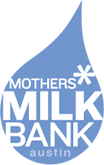The Issues With Milk Banking
As of the time of this writing, there are 26 not-for-profit human milk banks in North America, that's FIFTEEN more than when I first wrote up this page on my website in 2012. Needless to say, my heart is swollen with excitment and absolute love to know that so many more lives of the delicate babies are being saved!
When milk-banking first become something I wanted to wrap my heart around, there were quite a few circulating myths aroud town that led me to champion the cause on my private-practice's website. While just a few years later, I feel like the mommy-world has indeed understood why it's important for them to donate to milk-banks (more on that below) instead of only sharing their milk with healthy thriving babies in their communities (this is called informal milk--sharing), I still feel like not all of the mommy-world quite understands why not-for-profit milk-bank remain the better place for formal milk-sharing.
What is a not-for-profit milk-bank?
If the distinction has to be made that a milk-bank is a non-profit milk-bank, then that must mean that for-profit milk banks exists, right?
Yup. They do, and here's the difference:
A non-for-profit milk-bank accepts donations (they don't pay mothers to share their milk) and doesn't make money (profit) from the donations. The controversy here has been that non-profits do pass on a fee to the infant's family and health insurance. Because non-profits charge families and health insurance companies many would then ask how an agency that charges for something is really not profiting. Well, the quick answer to that is that every penny of the "profit" was used to keep a milk-bank's lights on, be able to purchase and maintain equipment, and to pay the hard working employees who run it. This is how non-profits operate-yes, they make money, but they put it back in to the agencies operating costs.
So then what about for-profit human milk-banks?
Well, for-profit milk-banks are just that: they make money (profit) off of human milk. For-profit milk-banks pay mothers (usually very little compared to how much they sell their milk for), yet profit from the milk they sell to families and insurance agencies. Other's collect a fee in order to connect mothers who are looking to sell their milk with families in need of breastmilk for their ill babies.
While the objective of this article isn't to name-drop (I don't need to, a quick google search will point you to for-profit milk-banks), it is to educate mothers who are considering sharing their breastmilk to donate it to milk-banks that will not profit off of your milk to then pay you close to nothing. While it may seem tempting, the ethics of selling something that is life-saving for a critically ill infant in the NICU is something to really think about. Another thing that normalizing for-profit milk bank "donations" has the potential to do is to create a market that is tempting enough for some mothers to sell their milk entirely instead of offering it to their own children.
To learn more about
When milk-banking first become something I wanted to wrap my heart around, there were quite a few circulating myths aroud town that led me to champion the cause on my private-practice's website. While just a few years later, I feel like the mommy-world has indeed understood why it's important for them to donate to milk-banks (more on that below) instead of only sharing their milk with healthy thriving babies in their communities (this is called informal milk--sharing), I still feel like not all of the mommy-world quite understands why not-for-profit milk-bank remain the better place for formal milk-sharing.
What is a not-for-profit milk-bank?
If the distinction has to be made that a milk-bank is a non-profit milk-bank, then that must mean that for-profit milk banks exists, right?
Yup. They do, and here's the difference:
A non-for-profit milk-bank accepts donations (they don't pay mothers to share their milk) and doesn't make money (profit) from the donations. The controversy here has been that non-profits do pass on a fee to the infant's family and health insurance. Because non-profits charge families and health insurance companies many would then ask how an agency that charges for something is really not profiting. Well, the quick answer to that is that every penny of the "profit" was used to keep a milk-bank's lights on, be able to purchase and maintain equipment, and to pay the hard working employees who run it. This is how non-profits operate-yes, they make money, but they put it back in to the agencies operating costs.
So then what about for-profit human milk-banks?
Well, for-profit milk-banks are just that: they make money (profit) off of human milk. For-profit milk-banks pay mothers (usually very little compared to how much they sell their milk for), yet profit from the milk they sell to families and insurance agencies. Other's collect a fee in order to connect mothers who are looking to sell their milk with families in need of breastmilk for their ill babies.
While the objective of this article isn't to name-drop (I don't need to, a quick google search will point you to for-profit milk-banks), it is to educate mothers who are considering sharing their breastmilk to donate it to milk-banks that will not profit off of your milk to then pay you close to nothing. While it may seem tempting, the ethics of selling something that is life-saving for a critically ill infant in the NICU is something to really think about. Another thing that normalizing for-profit milk bank "donations" has the potential to do is to create a market that is tempting enough for some mothers to sell their milk entirely instead of offering it to their own children.
To learn more about
- http://bridgemi.com/2015/10/the-politics-of-breast-milk-and-who-can-profit/
- http://kellymom.com/ages/bf-preemie/milk-bank-faq/


